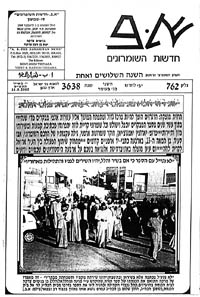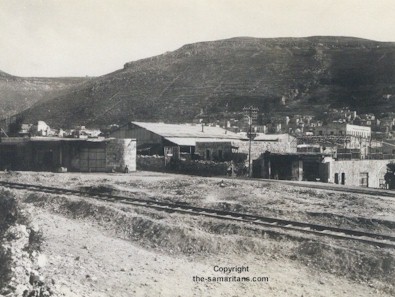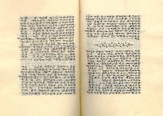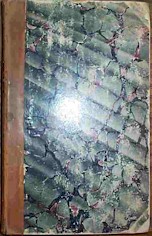
January 16th, 2003
In this Issue:
-
The Railroad Under Mount Gerizim
-
A
Pentateuch in Wyoming
-
Samaritan Music in America in 2003
-
Library
News:
-
Horae
Apocalypticae
-
Palestine's
Rural Economy
The Samaritan Update, a bi-weekly Internet Newsletter is a
division of the-samaritans.com.
Subscription is free via E-mail only.
-----
Editor: Shomron
Co-Editor: Osher
Sassoni
Staff Writer:
Staff Photographer:
Eyal Cohen
Staff Translator:
Guy Tsabary
Special Contributors: A. B. News Services
----
Contact information:
Shomron@Yahoo.com
Support our websites by informing your friends of the Samaritan/
Israelites and our web sites
Your link
to the Update Index
and to our
Web Site: The-Samaritans.com
Sign our Guest book Please!
Read and gain knowledge
at our website:
What have you read lately?
WANTED:
Spanish Translation Editor for establishing a
new Spanish section at our web site.
Please contact:
Shomron
shomron@yahoo.com
Support and Visit Our
Web Based Store
From Books to a Samaritan Interactive CD-ROM works
on Windows or Mac PC. Exhibiting many photos and mini-movies. It addresses
the Samaritan religion, their chronicles, community, language and literature.
The Samaritan Singers reform (Osher sings with them on this cd-rom) their
music on the CD-ROM. It is full of information.
Other items:
Samaritan Cookbook in Hebrew,
CD of the Samaritan Singers Assembly,
Check it out today!
Or if you are looking for something different. Interested parties can
contact us at
webmaster@The-Samaritans.com
Get your free
E-mail Address
from
www.The-Samaritans.com/ .
Just go to our web site and find
“get a free e-mail address” or go to
http://samaritan.i-p.com/
and register.
Let people know you are involved with the Samaritans.
Subscribe to
the
A. B.
The Samaritan News-
A Bi-Weekly Newspaper, written in four languages, sent around the world

Since 1969.
P. O. B. 1029, Holon 58110, Israel or
E-mail Benyamim and Yefet Tsedaka:
tsedakab@netvision.net.il
Back Issues Are
Available. |
The Railroad Under Mount Gerizim
Article by Shomron. Photo by Alvin B. Garley- 1930
The first railway in the holy land was constructed between Jerusalem
and Jaffa by a French concessionary company in 1892. The line was further
developed by the Turks
 with
help from the Germans in 1914 and by the British in 1920. During World War
I, the Turks extended the line southward from Afulah through Jenin to
Nablus. with
help from the Germans in 1914 and by the British in 1920. During World War
I, the Turks extended the line southward from Afulah through Jenin to
Nablus.
Most likely the railway was a convenient transportation for the pilgrims
of the Samaritan Passover. Moses Gaster most likely used this rail line as
well as many others. I sent an e-mail with the photo to Israel Railways
and received a response back from Paul Cotterell:
"Thanks
for the Nablus station photo. These are very rare indeed.
The line from
Afula to Nablus was begun in 1912 as a branch of the narrow gauge Hedjaz
Railway line to Haifa, and was intended to reach Jerusalem. The outbreak
of WW1 changed these plans. In 1915 the Turks altered the course of this
line to go from Massudiah to Tulkarm, Lod, and Beersheba into the Negev
Desert to support their campaign against the British in Egypt. Of the
planned extension to Jerusalem, only the section to Nablus was completed
(possibly by the British after September 1918). Traffic was only ever very
light, with maybe one train a day from Haifa/Afula to Nablus. The line was
damaged in The Disturbances of the late 1930s, and saw several periods out
of use. It was rehabilitated by the British army in WW2 for military
traffic, but closed completely about the end of the war (precise date
unknown). Apparently the track in the Jordanian held West Bank section was
only taken up about 1965."
A
Pentateuch in Wyoming
by
Anne
Marie Lane
In the American Heritage Center of the
university of Wyoming, USA there is in the Toppan Rare Books Library, a
Manuscript of the Pentateuch, apparently written in Samaritan characters.

What a pleasant
surprise to read an email from Shomron. It is the first inquiry I have
had (in my 9 years here) about the Samaritan Pentateuch. It is a special
favorite that I bring out for presentations on book history and books of
different religions. It is small, a hand-held version, just over 4
inches high and 3 inches wide, 400 pages long, hand-sewn with red
thread, and has the traditional "flap" binding. The leather is a light
to medium brown (goatskin?), and has an incised cross (like this: X ) on
both the front and back, each within a panel of incised lines. The spine
has 21 horizontal lines inscribed from top to bottom. The paper is very
thin, almost like modern airmail paper, and is a cream color. The ink
is extremely black, and the whole book is handwritten in a remarkably
tiny script.
I do not know the conditions of the book ending up here in Wyoming,
except to say that the manual cataloging record I have (the book is not
cataloged online yet) says it was acquired in 1967 as a William Fitzhugh
gift. Dr. Fitzhugh (of California) donated both books and money
to buy other books, so I'm not sure if he himself had bought it while
traveling somewhere. The cataloging record also notes that it is from
"Nablus, Palestine, circa 1750," so it is quite old.
Anne Marie Lane
Faculty Curator of
Rare Books
Toppan Library,
American Heritage Center
P.O. Box 3924,
University of Wyoming, Laramie, WY 82071
http://www.uwyo.edu/ahc/depts/toppan/toppan.htm
http://uwadmnweb.uwyo.edu/ahc/depts/toppan/pentateuch.htm
Samaritan Music in America in 2003
A.
B. News Services
Further steps have been made to arrange a successful
journey of performances of the Samaritan Israelite Music Ensemble of 20
singers of both Samaritan Communities in
Holon
and Kiriat Luza. The ensemble has already been booked for the
international festival of Coral Music that will take place in
Missoula/Montana on July, 16-20, 2003. Benyamim Tsedaka met the
executive of the festival at a special lunch
that was arranged for him. Now in many places over the
USA, like New York City, Washington D.C., San Francisco, Salt Lake City
and San Diego, friends of the Samaritan culture are helping to set up more
performances for the Ensemble, who
sings the most ancient music in existence.
Library
News:
Books and
Articles
Conntinuation of
the Samaritan Chronicle of Abu L'Fath
by
Milka Levy-Rubin Hardcover
Book
Darwin Pr; ISBN:
0878501363; (October 2002)
At Amazon.com for $35.00 plus shipping.
-------------------------------------
Article by
Werner Arnold
A more general
article on the Arabic dialects in the Tel-Aviv area includes the dialect
of the Samaritans of
Holon. This
article will be published in German language in the Festschrift. A second article on the Arabic dialect of the Samaritans
will be published in the proceedings of the 6th international conference
on Arabic dialectologie in Cadiz. This article will be in English. A Text
in Samaritan Arabic spoken by Benjamim Tsedaka will be published with a
German translation in the Festschrift. I hope, that
all publications will appear during this year.
The spoken text will be included also in our Semitic language archive.
There you can listen also to a lot of other (also Jewish Arabic) dialects.
See:
http://semarch.uni-hd.de/
---Prof. Dr.
Werner Arnold,
Universität Heidelberg, Seminar für Sprachen und Kulturen des Vorderen
Orients
—Semitistik— Schulgasse 2, 69117 Heidelberg,
http://arnold.uni-hd.de/
-------------------------------------
Rare Arabic Book
 Author: Bible-Arabic
1854 Author: Bible-Arabic
1854
Title: Libri Exodi et Levitici secundum Arabicam Pentateuchi Samaritani
versionem, Ab Abu-Saido conscriptam, quos ex tribus
Publisher: E. J. Brill Leiden 1854.
Description: leather spine,ex-library. conscriptam, quos ex tribus
codicibus edidit A. Kuenen.
Book ID: 045867
Price:
US$187.50
Crown
number 1900, Abraham Kuenen.
Interested
parties can contact:
Richard Owen Roberts Booksellers &
Publishers
PO Box 21, 123-145 N. Washington St.Wheaton, IL 60189
(630) 752-4122 Phone,(630) 653-8616 Fax
sales@rorbooks.com
www.rorbooks.com
HORAE
APOCALYPTICAE, OR
A COMMENTARY
ON THE APOCALYPSE, CRITICAL AND
HISTORICAL
BY THE REV. E.
B. ELLIOTT, A. M.
I
quote this from a Paper on the subject, in the Christian Observer for May
1802, p. 287; and, in further illustration of the uniformity of the Hebrew
copies in respect of their numerals, may add that the Chaldee Paraphrase
of Onkelos, written about the time of Christ, agrees with the Hebrew
chronologies, -- that the same are recognized in the two Talmuds, -- and
that Dr. Wolff informs me that "in the ancient manuscripts which he saw at
Bokhara, the chronological notices of the length of lives both of the
antediluvian and the postdiluvian patriarchs were exactly according to the
received Hebrew text, though the letters of the manuscripts resembled
Samaritan."
http://www.heraldmag.org/olb/bsl/03%20Horae%20First%20Edition%20Chronology.htm
You can
read
Dr. Wolff's Journey to Bokhara. The Living Age,
vol. 6, issue 67 (August 23, 1845).
http://cdl.library.cornell.edu/moa/
This is a good book for discovery Wolff's
thoughts on the ten lost tribes of Israel.
"Palestine's
Rural Economy, 1917 - 1939"
By Kenneth W. Stein
'Devastation caused by the fighting in Palestine during World War I
adversely affected the rural economy and the peasants' financial
situation. The economy in general suffered from a severe decline in
currency value and available capital. The inhabitants of Gaza bartered
pottery for cereal from northern Palestine. The more densely populated
area from Nablus to Jerusalem barely provided enough agricultural produce
for local consumption. Administratively, the headlong Turkish retreat
brought about the destruction of sub-district land registers and
agricultural bank records, leaving virtually no complete and accurate
picture of land rights......'
'In 1913,
there was a serious epidemic which reduced sheep flocks, cattle stock, and
the number of transport oxen. The Turks commandeered huge camel stocks in
1915 and 1916. In 1916 they requisitioned large flocks of sheep near
Beersheba and in 1917 the hill regions from Nablus to Hebron suffered a
scarcity of sheep ....'
'From
1931 through 1933 there was a 37% drop in domestic wheat output in
Palestine. This forced the administration to issue loans for seed, plow
oxen, and forage, and to remit the tithe from 1931 through 1934. In Jenin
in early 1934, Arab journalists reported that 60% of the stock and 90% of
the offspring perished due to scanty grazing, inclement weather, and
drought; in Nablus the cold weather and lack of pasturage took their toll
of 60% of the remaining stock. This resulted in the government's remission
of the animal tax. In the early 1930s there was a steady decline in the
price of domestic wheat and cereals, primarily because of the dumping of
Syrian wheat on the Palestine market and worldwide overproduction.'
http://www.emory.edu/COLLEGE/JewishStudies/stein/Scholarly%20Journal%20Articles/Pal%20Rural%20economy.html
(This time period must have been
very hard on the Samaritans. Shomron)
Thank you!
We would like to thank you for
visiting our website,
The-Samaritans.com
in the past and hope you visit us again real soon. We ask you to forward
this Update to your friends. The purpose at our web site is the
education of the existence and history of the Samaritan-Israelites,
descendants of the ancient Kingdom of Israel. Recently we have been
working on expanding our web site. We do hope you enjoy visiting our
site and recommend it to your friends. Again we thank you for visiting
us at
The-Samaritans.com .
Take care and may you be blessed from the Holy One from above.
|


 with
help from the Germans in 1914 and by the British in 1920. During World War
I, the Turks extended the line southward from Afulah through Jenin to
Nablus.
with
help from the Germans in 1914 and by the British in 1920. During World War
I, the Turks extended the line southward from Afulah through Jenin to
Nablus.
 Author: Bible-Arabic
1854
Author: Bible-Arabic
1854